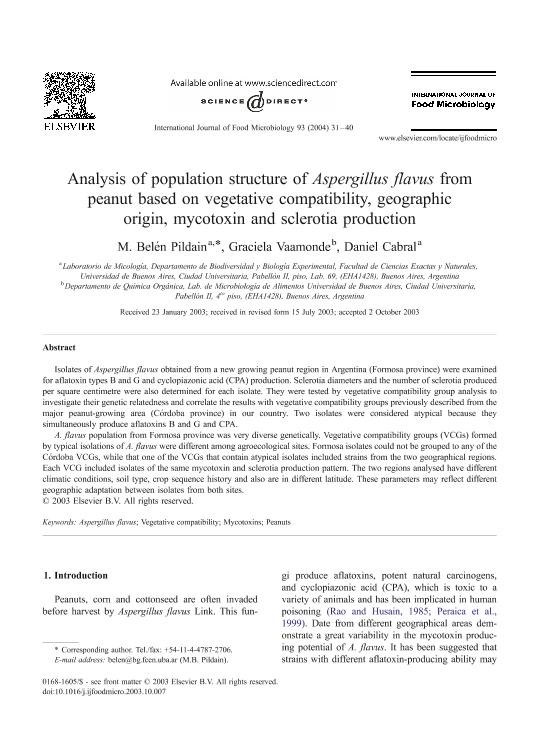Artículo
Analysis of population structure of Aspergillus flavus from peanut based on vegetative compatibility, geographic origin, mycotoxin and sclerotia production
Fecha de publicación:
15/05/2004
Editorial:
Elsevier Science
Revista:
International Journal of Food Microbiology
ISSN:
0168-1605
e-ISSN:
1879-3460
Idioma:
Inglés
Tipo de recurso:
Artículo publicado
Clasificación temática:
Resumen
Isolates of Aspergillus flavus obtained from a new growing peanut region in Argentina (Formosa province) were examined for aflatoxin types B and G and cyclopiazonic acid (CPA) production. Sclerotia diameters and the number of sclerotia produced per square centimetre were also determined for each isolate. They were tested by vegetative compatibility group analysis to investigate their genetic relatedness and correlate the results with vegetative compatibility groups previously described from the major peanut-growing area (Córdoba province) in our country. Two isolates were considered atypical because they simultaneously produce aflatoxins B and G and CPA.
A. flavus population from Formosa province was very diverse genetically. Vegetative compatibility groups (VCGs) formed by typical isolations of A. flavus were different among agroecological sites. Formosa isolates could not be grouped to any of the Córdoba VCGs, while that one of the VCGs that contain atypical isolates included strains from the two geographical regions. Each VCG included isolates of the same mycotoxin and sclerotia production pattern. The two regions analysed have different climatic conditions, soil type, crop sequence history and also are in different latitude. These parameters may reflect different geographic adaptation between isolates from both sites.
Palabras clave:
Aspergillus
,
Flavus
,
Vegetative Compatibility
,
Mycotoxins Peanuts
Archivos asociados
Licencia
Identificadores
Colecciones
Articulos(CCT-CENPAT)
Articulos de CTRO.CIENTIFICO TECNOL.CONICET - CENPAT
Articulos de CTRO.CIENTIFICO TECNOL.CONICET - CENPAT
Articulos(INMIBO (EX - PROPLAME))
Articulos de INSTITUTO DE MICOLOGIA Y BOTANICA
Articulos de INSTITUTO DE MICOLOGIA Y BOTANICA
Citación
Pildain, María Belén; Vaamonde, Graciela; Cabral, Daniel; Analysis of population structure of Aspergillus flavus from peanut based on vegetative compatibility, geographic origin, mycotoxin and sclerotia production; Elsevier Science; International Journal of Food Microbiology; 93; 1; 15-5-2004; 31-40
Compartir
Altmétricas




